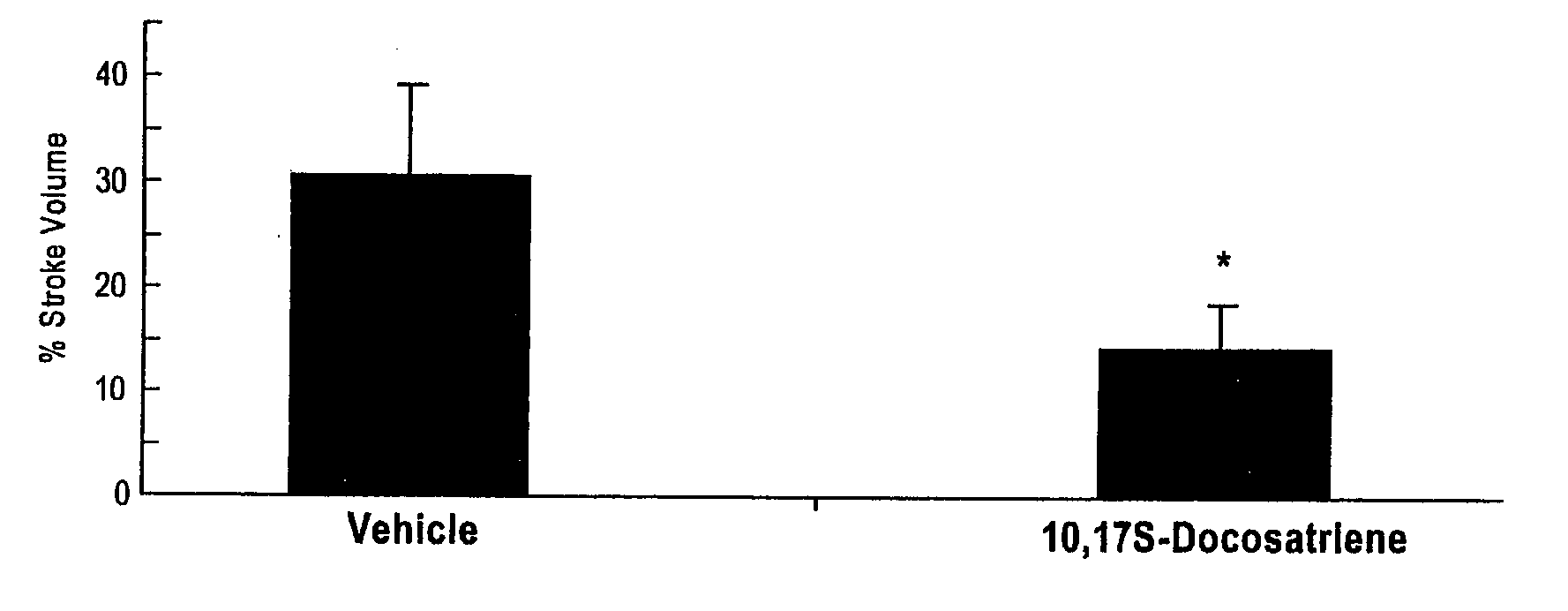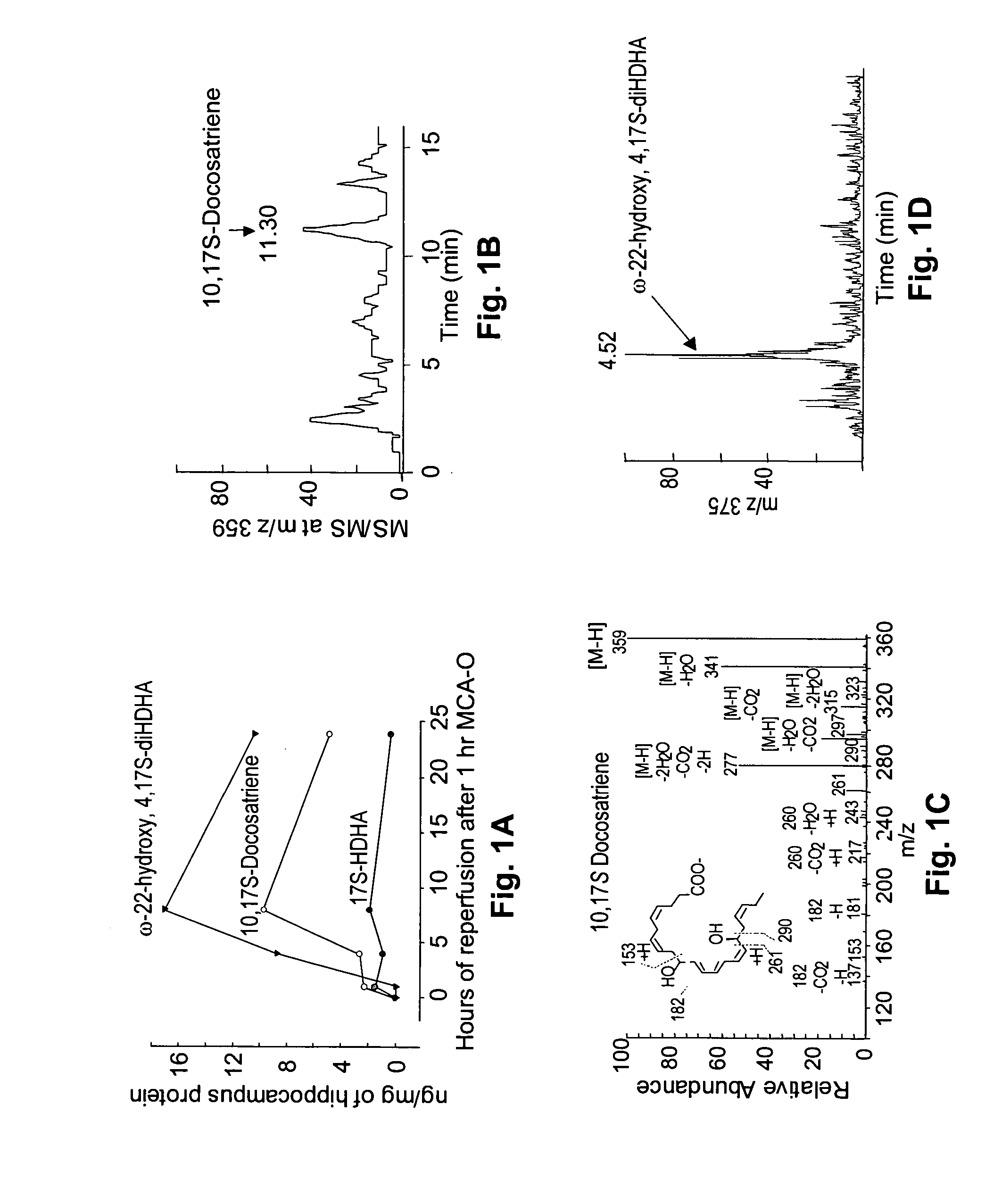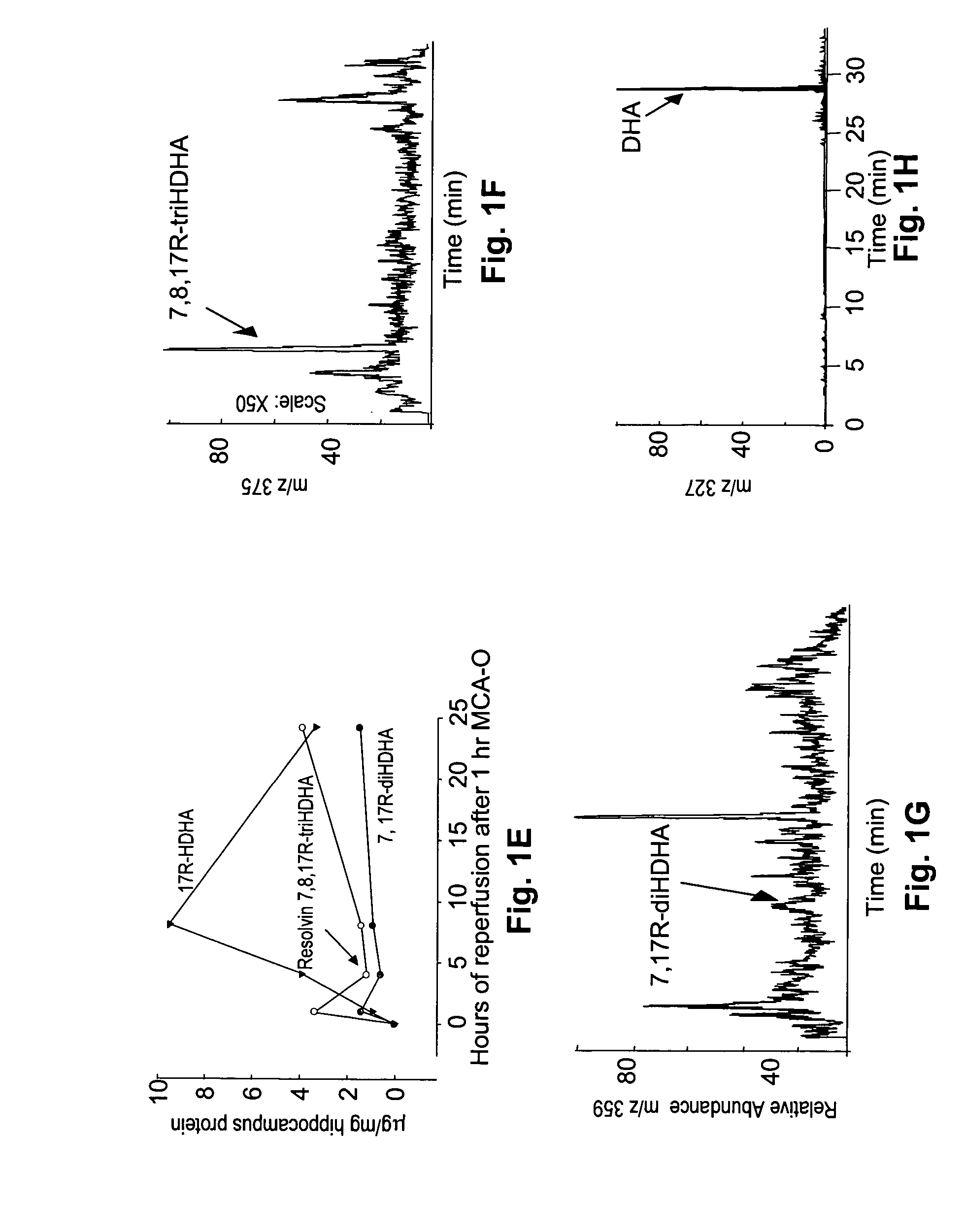Neuroprotectin D1 protects against cellular apoptosis, stroke damage, alzheimer's disease and retinal diseases
a technology of neuroprotectin and d1 is applied in the field of neuroprotectin d1 protecting against cellular apoptosis, stroke damage, alzheimer's disease and retinal diseases, which can solve the problems of cell death, impaired photoreceptor function, and unexplored physiologic properties of a peptides, and achieve neuroprotective effects, enhance a peptide secretion, and reduce the secretion of neurotoxic a40
- Summary
- Abstract
- Description
- Claims
- Application Information
AI Technical Summary
Benefits of technology
Problems solved by technology
Method used
Image
Examples
example 1
Materials and Methods for NPD1 Neuroprotection Following Stroke Damage
[0070] Reagents. Human recombinant IL-1β, (14019) was from Sigma Chemical Co. (St. Louis, Mo.), and 10,17-diHDHA was prepared as previously described in Serhan, C. N., Clish, C. B., Brannon, J., Colgan, S., Chiang, N., and Gronert, K. (2000) J. Exp. Med., 192, 1197-1204; and Bederson, J. B., Pitts, L. H., Tsuji, M., Nishimura, M. C., Davis, R. L., and Bartkowski, H. (1986) Stroke 17, 472-476. Normal human neural (HN) progenitor cells (CC-2599), NPMM (neural progenitor maintenance medium), human epidermal and fibroblast growth factors (hEGF, hFGF), gentamicin / amphotericin B (G / A1000), and neural survival factor-1 (NSF-1) were obtained from Clonetics (Walkersville, Md.). AP1, HIF-1α, NF-κBp50 / p65, and STAT-1α gel-shift consensus and mutant oligonucleotides were synthesized at the LSUHSC core facility or were purchased from Promega Life Science (Madison, Wis.).
[0071] Middle Cerebral Artery Occlusion (MCA-O) and rep...
example 2
Brain Ischemia-Reperfusion Triggered the Synthesis of Docosahexaenoic Acid-Oxygenation Pathways
[0081] Right middle cerebral artery occlusion in mice for 1 h followed by reperfusion was used to assess the formation of docosahexaenoic acid (DHA)-oxygenation derivatives. Under these conditions there is active release of free docosahexaenoic acid from brain membrane phospholipids. This model of transient focal ischemia greatly affects the hippocampus, a brain region rich in neurons vulnerable in ischemic stroke, and in other neurologic diseases as described in Bazan, N. G., and Allan, G. (1998) In Cerebrovascular Disease: Pathophysiology, Diagnosis, and Management, eds. Ginsberg, M. D. and Bogousslavsky, J. (Blackwell Science, Inc., Maiden, Mass.) pp. 532-555.
[0082]FIGS. 1A-1H indicate the synthesis and metabolism of docosanoids in the ipsilateral mouse hippocampus during reperfusion following transient ischemia. The structural elucidation of DHA and docosanoids was performed by lipid...
example 3
Polymorphonuclear Leukocyte Infiltration Mediated by Focal Ischemic Stroke in Mice is Inhibited by 10,17S-docosatriene (NPD1)
[0093] Polymorphonuclear leukocyte (PMN) infiltration, a major factor in mediating brain ischemia-reperfusion damage was monitored. PMN infiltration is a complex, multi-step process that is modulated by the coordinated expression of adhesion and signaling molecules. DHA-derived messengers were very recently reported to inhibit PMN invasion outside the central nervous system, in the air-pouch model. (Hong et al., 2003).
[0094] To determine whether 10,17S-docosatriene (NPD1) affected brain ischemia-reperfusion-induced PMN infiltration, either DHA or 10,17S-docosatriene (NPD1) was constantly infused into the third ventricle of a mouse brain during 48 h of reperfusion. FIGS. 5A, 5B, and 5C show the inhibition of leukocyte infiltration by 10,17S-docosatriene (NPD1) in mouse hippocampus and neocortex after 1-h MCA-O and 48 h of reperfusion. The data shown represent...
PUM
 Login to View More
Login to View More Abstract
Description
Claims
Application Information
 Login to View More
Login to View More - R&D
- Intellectual Property
- Life Sciences
- Materials
- Tech Scout
- Unparalleled Data Quality
- Higher Quality Content
- 60% Fewer Hallucinations
Browse by: Latest US Patents, China's latest patents, Technical Efficacy Thesaurus, Application Domain, Technology Topic, Popular Technical Reports.
© 2025 PatSnap. All rights reserved.Legal|Privacy policy|Modern Slavery Act Transparency Statement|Sitemap|About US| Contact US: help@patsnap.com



